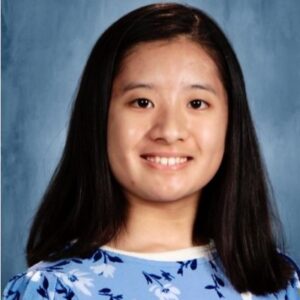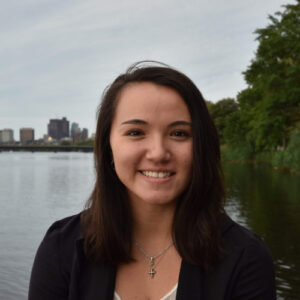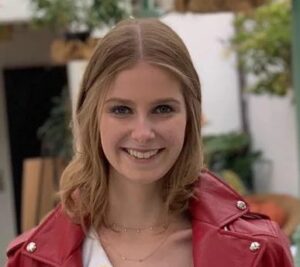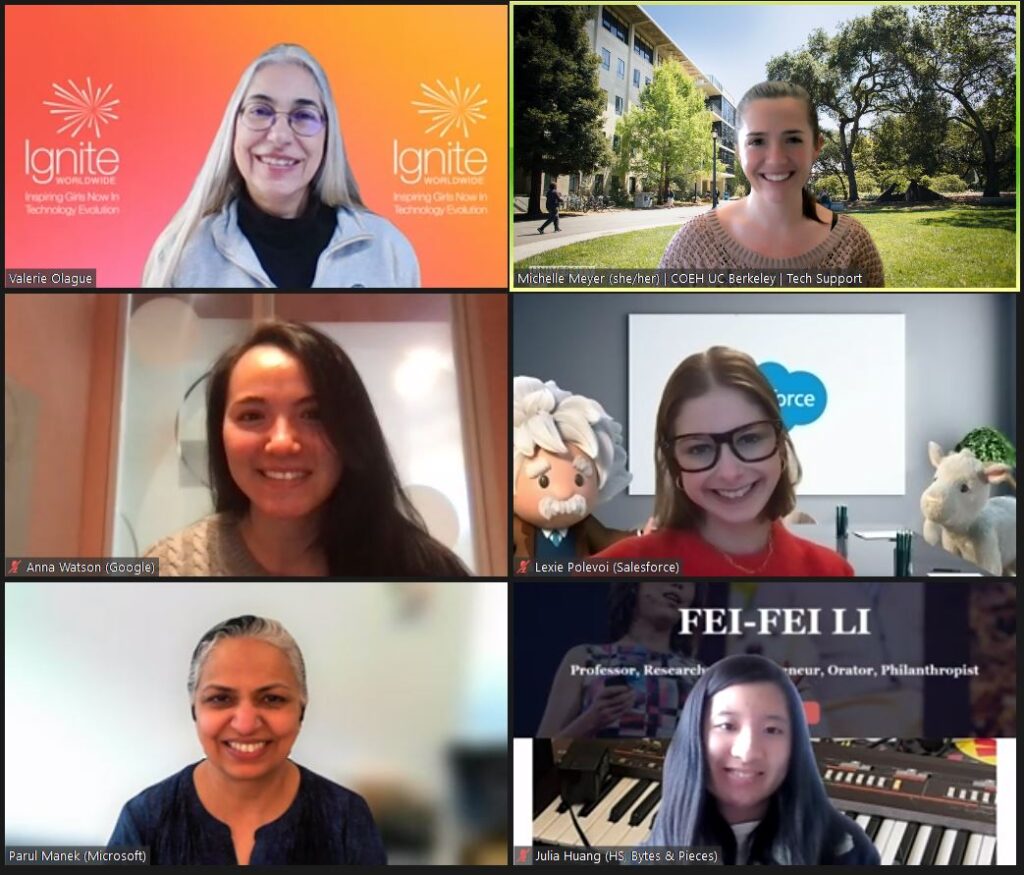Students from five middle schools across Bethel School District attended an IGNITE Virtual Panel on March 15, 2022. Facilitator Valerie Olague worked in STEM for 37 years and retired from Microsoft at the end of 2021, and is enjoying volunteering with organizations like IGNITE and the Seattle Humane Society. Valerie emphasized that STEM includes areas that people often think of like programming and coding, and also includes fields from fashion to data science and more. STEM careers are well-paid and very available, with more job openings than professionals to hire.
Valerie introduced Tech Host Michelle Meyer, Director, Continuing Education at the University of California, Berkeley Center for Occupational and Environmental Health, and shared that this panel was made up of women at different points in their STEM careers.
After this introduction, Valerie asked Panelists to introduce themselves.

Julia Huang is a junior in high school and Founder and President of Bytes & Pieces, which hosts music and STEM workshops for middle school and high school students. Julia’s grandfather bought a piano in the ‘80s that has stayed in her family, and she got her interest in STEM in 8th grade, when she started learning Scratch in school. She has combined her interests to create a variety of websites, including one that shows visualizations of music. Julia encourages students to take classes in web development, use online tools like w3schools, and combine your interests in new ways.

Anna Watson, a Software Engineer, recently started her role at Google Cloud, supporting a lot of back-end work. Anna’s parents were very supportive of her, along with her teachers who kept encouraging her to pursue engineering, though she didn’t know what this was at first! She started her career in computer science after she saw a friend’s assignment in her first year in college, and she loved the problem-solving aspects of STEM. She encourages students to follow their interests, even if things seem potentially scary or nerve-wracking. Though she wasn’t working on computers at a young age, she used the same parts of her brain to do things like figure out how to shoot Nerf guns faster or take apart the toilet.

Lexie Polevoi works at Salesforce as a Product Manager, someone who gets to work with different teams to help make the products that you use every day better. Lexie works on web chat, improving the experience for customers. She went to an all-girls elementary school, which gave her a lot of confidence as a woman. She grew up in a family of doctors, and got her first exposure to STEM outside of medicine through a Girls Who Code club in middle school. She loved her STEM classes and kept pushing herself to study different classes and do the very best she could. She has learned that you don’t have to have a 4.0 to keep learning and be successful.

Parul Manek, Partner Director of Program Management at Microsoft, has been in the industry for over 30 years, when STEM was not even a popular acronym. Now, she leads a team of 140 people across the world. She failed many exams in India because she didn’t care for school—she wanted to learn about laying bricks, electrical sockets, and more. She learned she had a passion and aptitude for math after she started studying math at 16 to avoid taking more English classes; at 18 she realized how much she enjoyed the math she was learning. Nowadays, she has a little wizard figurine on her desk because she is a wizard at work, solving problems and making things happen. She still enjoys building with legos and doing jigsaw puzzles, and says you get to keep playing as an adult if you want!
Next, students asked the Panelists questions about their experience and backgrounds.
How hard is it to run a website? What is a website you can use to learn different coding languages/website coding languages? Julia recommends starting with SquareSpace, Weebly, Wix, and other drag-and-drop coding languages to make a website and then continuing with CSS or HTML. She also suggests using websites like replit.com to code and deploy a website.
What has been your favorite project you’ve worked on? Anna said that a lot of her projects are back-end, but she got to design a calendar as an intern to help show when updates were coming up. She got to collaborate with a lot of people who were doing interesting work to help make this project the best it could be.
What is the hardest problem you’ve solved? Parul was not allowed to attend a Lego club for students who excelled in math. She went and stood outside the classroom for four weeks until they let her sit in the back of the class, and then she asked to help clean. By the third week, she was playing with Legos with her fellow students! Currently, her hardest problem is reducing Microsoft’s carbon footprint, as Microsoft has set a goal of carbon neutrality by 2030.

Are there STEM jobs you can do without math or science? Yes! On Parul’s team, many people work on identifying how to solve problems. There is a lot of design and planning that goes into products like Google Sheets or Zoom, showing what things look like. Project Managers help figure out the steps to solve problems.
Final round of advice—what do you wish you had known when you were in middle school?
- Julia: It’s never too late to learn anything you want, as long as you’re interested, and you can pursue multiple interests as well.
- Anna: It’s OK to ask questions about anything and everything—people love sharing what they know.
- Lexie: Don’t be afraid to go into areas where people don’t look like you—that’s why you should go into them.
- Parul: Be curious, and don’t lose who you are just to please people. Be true to who you are; that’s what will stay with you for the rest of your life.
Thank you to all the volunteers who made this event possible—Facilitator Valerie Olague, Tech Host Michelle Meyer, and Panelists Julia Huang, Anna Watson, Lexie Polevoi, and Parul Manek, and special thanks to Julia for also capturing notes from this event. Special thanks to Teacher Gina Mork for coordinating on behalf of Bethel School District.
After attending this event:
Here’s what the students thought of the event:
“It showed me that I can use my gaming and art skills to pursue a future career. It also helped show me that no matter how difficult things may get, keep persevering and you’ll reach your goal eventually!” – 8th grade
“It was really cool to see different people’s perspectives. Also hearing people’s stories was really inspiring.” – 6th grade
“I was inspired by seeing the variety of things that they do. I think it’s good that you can be good at different things and find something you love in STEM. There are lots of different jobs in STEM.” – 7th grade
“Thank you for answering our questions and describing your jobs. Thank you for the confidence and support you shared with us.” – 7th grade
“It motivated me because it’s nice to see so many women in STEM careers while most of the positions are filled by men. It’s nice to see women in these jobs too.” – 8th grade
“They made me feel more comfortable and gave me many different ideas for jobs in STEM.” – 7th grade
“It inspired me to be more interested in STEM.” – 6th grade
“This event inspired me to go for what my heart believes in. If I want it I can work for it.” – 7th grade
“This was helpful. All of this seems really cool. I really love to learn more. I didn’t know any of this stuff.” – 7th
“This event made me inspired to work in STEM. It also made me want to help out with programming.” – 6th grade
“STEAM isn’t just about math and science and that got me inspired.” – 7th grade
“It inspired me by helping me get more comfortable in STEM.” – 6th grade
“It inspired me to know what I can do in my future.” – 6th grade
“I loved it. I’m glad to be here.” – 6th grade
“It was very interesting!” – 6th grade